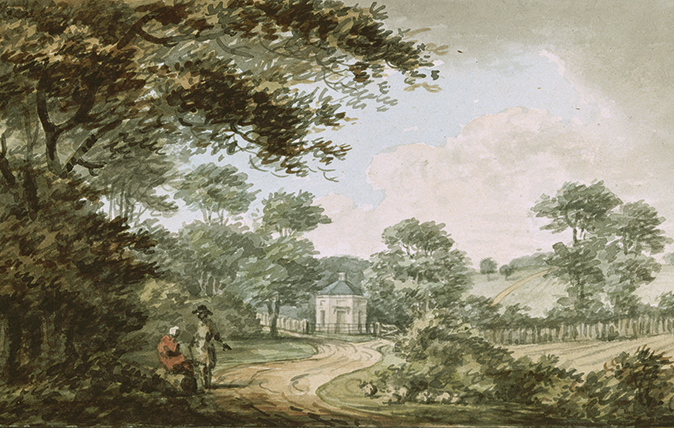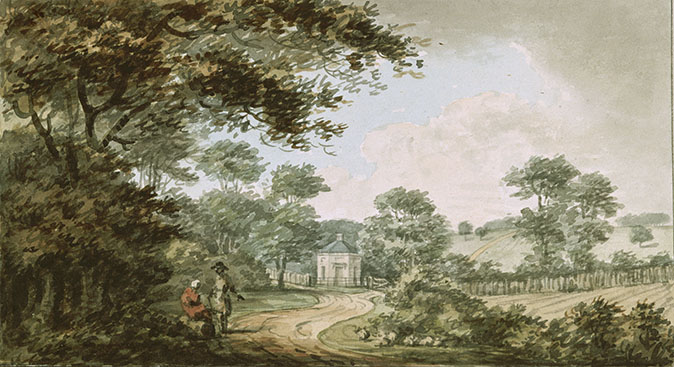My favourite painting: George Carter
'When I bought Dorothy Stroud’s pioneering book on Repton, shortly after its publication in 1962, I was enthralled by his vision of the British landscape'



Lamer House, Hertfordshire (Red Book proposal), 1792, by Humphry Repton (1752–1818), 7½in by 4¼in, private collection
George Carter says: When I bought Dorothy Stroud’s pioneering book on Repton, shortly after its publication in 1962, I was enthralled by his vision of the British landscape and especially impressed by the way he could cogently explain why and how his suggested improvements would work. The watercolour visuals he produced for his famous Red Books have the seductive effect of showing a scheme in its maturity, often contrasted against the unsatisfactory present state; they must have played a major part in his rapid rise to success .
George Carter is a garden designer. His new book, Setting the Scene, explores the enduring relevance of Repton’s ideas today.
John McEwen comments on Lamer House, Hertfordshire: Humphry Repton coined the term ‘landscape gardening’ to convey ‘the united powers of the landscape painter and the practical gardener’. He sold his clients a Red Book (a slim manual in red leather) illustrated with watercolours that depicted—through his invention of ‘before and after’ flaps – his proposals. His predecessors in this new art of pleasing, manmade landscapes – most famously Lancelot ‘Capability’ Brown – produced plans, rather than an amusing (complete with peppery text) and ingenious book of transformable pictures.
Repton was born in Bury St Edmunds, his father an excise collector who later had a transport business in Norwich. He attended Norwich Grammar School and, at 12, was sent to the Netherlands to learn Dutch in order to be a merchant. The young Repton found his vocation after a series of false and financially unsuccessful starts – he was 36, with a wife, four children and no fixed income, when he decided to fill the shoes of Brown, who had died in 1783.
Repton’s clients ranged from the Prince Regent to large landowners and merchants or bankers with country ‘boxes’. His client at Lamer, which was demolished after the Second World War, was C. Drake Garrard, ancestor of Apsley Cherry Garrard, author of The Worst Journey in the World (1922), about Scott’s ill-fated expedition.
Repton was very busy in the early 1790s, as he states in this Red Book. Although he worked right up until his death, many consider he was at the height of his powers in the 1790s, both as a watercolourist and as a designer who could orchestrate, by relatively simple means, great improvements to the landscape and garden setting of houses.
Sign up for the Country Life Newsletter
Exquisite houses, the beauty of Nature, and how to get the most from your life, straight to your inbox.
Country Life is unlike any other magazine: the only glossy weekly on the newsstand and the only magazine that has been guest-edited by HRH The King not once, but twice. It is a celebration of modern rural life and all its diverse joys and pleasures — that was first published in Queen Victoria's Diamond Jubilee year. Our eclectic mixture of witty and informative content — from the most up-to-date property news and commentary and a coveted glimpse inside some of the UK's best houses and gardens, to gardening, the arts and interior design, written by experts in their field — still cannot be found in print or online, anywhere else.
-
 380 acres and 90 bedrooms on the £25m private island being sold by one of Britain's top music producers
380 acres and 90 bedrooms on the £25m private island being sold by one of Britain's top music producersStormzy, Rihanna and the Rolling Stones are just a part of the story at Osea Island, a dot on the map in the seas off Essex.
By Lotte Brundle
-
 'A delicious chance to step back in time and bask in the best of Britain': An insider's guide to The Season
'A delicious chance to step back in time and bask in the best of Britain': An insider's guide to The SeasonHere's how to navigate this summer's top events in style, from those who know best.
By Madeleine Silver
-
 'As a child I wanted to snuggle up with the dogs and be part of it': Alexia Robinson chooses her favourite painting
'As a child I wanted to snuggle up with the dogs and be part of it': Alexia Robinson chooses her favourite paintingAlexia Robinson, founder of Love British Food, chooses an Edwin Landseer classic.
By Charlotte Mullins
-
 The Pre-Raphaelite painter who swapped 'willowy, nubile women' for stained glass — and created some of the best examples in Britain
The Pre-Raphaelite painter who swapped 'willowy, nubile women' for stained glass — and created some of the best examples in BritainThe painter Edward Burne-Jones turned from paint to glass for much of his career. James Hughes, director of the Victorian Society, chooses a glass masterpiece by Burne-Jones as his favourite 'painting'.
By Charlotte Mullins
-
 'I can’t look away. I’m captivated': The painter who takes years over each portrait, with the only guarantee being that it won't look like the subject
'I can’t look away. I’m captivated': The painter who takes years over each portrait, with the only guarantee being that it won't look like the subjectFor Country Life's My Favourite Painting slot, the writer Emily Howes chooses a work by a daring and challenging artist: Frank Auerbach.
By Toby Keel
-
 My Favourite Painting: Rob Houchen
My Favourite Painting: Rob HouchenThe actor Rob Houchen chooses a bold and challenging Egon Schiele work.
By Charlotte Mullins
-
 My Favourite Painting: Jeremy Clarkson
My Favourite Painting: Jeremy Clarkson'That's why this is my favourite painting. Because it invites you to imagine'
By Charlotte Mullins
-
 The chair of the National Gallery names his favourite from among the 2,300 masterpieces — and it will come as a bit of a shock
The chair of the National Gallery names his favourite from among the 2,300 masterpieces — and it will come as a bit of a shockAs the National Gallery turns 200, the chair of its board of trustees, John Booth, chooses his favourite painting.
By Toby Keel
-
 'A wonderful reminder of what the countryside could and should be': The 200-year-old watercolour of a world fast disappearing
'A wonderful reminder of what the countryside could and should be': The 200-year-old watercolour of a world fast disappearingChristopher Price of the Rare Breed Survival Trust on the bucolic beauty of The Magic Apple Tree by Samuel Palmer, which he nominates as his favourite painting.
By Charlotte Mullins
-
 My favourite painting: Andrew Graham-Dixon
My favourite painting: Andrew Graham-Dixon'Lesson Number One: it’s the pictures that baffle and tantalise you that stay in the mind forever .'
By Country Life